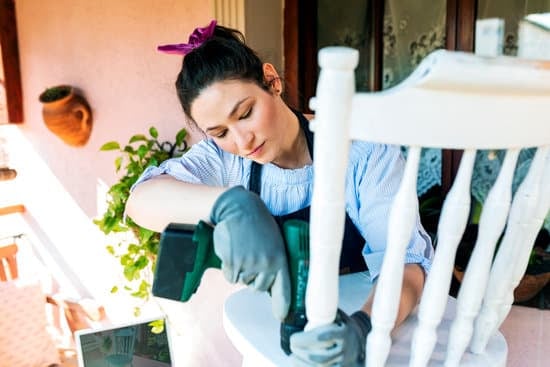When considering a home improvement project, one of the key factors to take into account is how to finance it. Home improvements not only enhance the aesthetic appeal of a property but also increase its value and functionality. So, what kinds of loans are there for home improvement? Homeowners have a variety of options available to them when it comes to financing their renovation projects.
Whether it’s upgrading a kitchen, adding an extra room, or making necessary repairs, loans can help homeowners achieve their desired enhancements. Personal loans are a common choice for those looking to fund their home improvement endeavors. These loans provide flexibility in terms of usage and repayment options. However, it’s essential to weigh the advantages and disadvantages before committing to this type of financing.
Another popular option for funding home improvements is through home equity loans. By leveraging the equity built up in their property, homeowners can access substantial funds for renovation projects at potentially lower interest rates compared to personal loans. Understanding how these loans work and their implications on your home’s equity is crucial when considering this financing option.
Types of Loans Available for Home Improvement
When considering home improvement projects, homeowners often face the challenge of determining how to finance their endeavors. Thankfully, there are a variety of loans available specifically for this purpose. Understanding the different types of loans for home improvement can help homeowners make informed decisions about their financing options. In this section, we will explore the various loan options available, highlighting the features, benefits, and potential drawbacks of each.
Personal Loans
One common option for financing home improvement projects is through personal loans. These unsecured loans allow homeowners to borrow a specific amount of money that can be used towards renovations or upgrades. Personal loans typically have fixed interest rates and monthly payments over a set term, making budgeting for the project easier.
However, it’s essential to note that personal loans may have higher interest rates compared to other options such as home equity loans or lines of credit. Homeowners should carefully consider their credit score and financial situation before opting for a personal loan for home improvements.
Home Equity Loans
Another popular choice for funding home renovation projects is through home equity loans. Home equity loans allow homeowners to borrow against the equity in their property, using their home as collateral. This type of loan often comes with lower interest rates than personal loans because it is secured by the value of the property.
Additionally, home equity loans typically offer longer repayment terms and larger loan amounts compared to personal loans. However, it’s crucial to understand that failure to repay a home equity loan could result in losing your property through foreclosure. Homeowners should assess their equity position and ability to repay before considering this financing option.
Home Equity Line of Credit (HELOC)
A Home Equity Line of Credit (HELOC) provides another avenue for homeowners looking to finance their home improvement projects using their home’s equity as collateral. Unlike traditional home equity loans which provide a lump sum at closing, HELOCs operate similarly to credit cards where borrowers can draw funds up to a predetermined limit during a specified draw period.
One benefit of HELOCs is that borrowers only pay interest on the amount they use rather than on the entire approved line of credit.
However, HELOCs come with variable interest rates which can fluctuate over time based on market conditions. Homeowners should weigh the pros and cons between HELOCs and traditional home equity loans before deciding on which option suits their needs best.
Personal Loans
One of the main advantages of using a personal loan for home improvement is the flexibility it offers. Borrowers can use the funds for any aspect of their renovation project without restrictions.
Additionally, personal loans typically have fixed interest rates and monthly payments, making it easier for homeowners to budget and plan their expenses. Another advantage is that personal loans do not require any equity in the home, so even first-time buyers or those with little equity built up in their property can still qualify.
However, there are also some disadvantages to consider when using a personal loan for home improvement. Personal loans often come with higher interest rates compared to other types of financing options, such as home equity loans or contractor loans. This means that borrowers may end up paying more in interest over time.
Additionally, the loan amounts for personal loans are typically lower than with other types of loans, so homeowners with larger renovation projects may need to explore alternative financing options. It’s important for homeowners to carefully consider their financial situation and evaluate all loan options available to determine which one best fits their needs and budget.
Home Equity Loans
When considering a home equity loan for home improvement, homeowners should keep in mind that the loan amount is based on the difference between the current market value of the property and the outstanding mortgage balance. This means that the amount you can borrow through a home equity loan will depend on how much equity you have in your home. Additionally, repayment terms for home equity loans are often fixed, which can provide predictability in budgeting for your renovation project.
One important aspect to consider before opting for a home equity loan is that your home serves as collateral for the loan. This means that if you are unable to repay the loan as agreed, you risk losing your home to foreclosure.
It’s essential to carefully assess your financial situation and ability to make payments before committing to a home equity loan for your renovation project. Consulting with a financial advisor can also help you determine if this type of financing is suitable for your needs and goals.
- Lower interest rates compared to other types of loans
- Loan amount based on available equity in your home
- Repayment terms are often fixed
Home Equity Line of Credit (HELOC)
A Home Equity Line of Credit (HELOC) is a popular option for homeowners looking to finance their home improvement projects. A HELOC allows homeowners to borrow against the equity in their home, which is the difference between the current market value of the property and the outstanding mortgage balance.
This type of loan provides flexibility in terms of how much money can be borrowed and when it can be accessed, making it an attractive choice for those with varying renovation needs.
When considering a HELOC for home improvement, it’s important to understand the differences between a HELOC and a traditional home equity loan. While both types of loans use your home as collateral, a home equity loan provides a lump sum upfront, while a HELOC allows you to borrow funds as needed, similar to a credit card.
Additionally, with a home equity loan, you typically receive a fixed interest rate and monthly payments, whereas with a HELOC, you may have a variable interest rate and only pay on the amount borrowed.
Like any financial product, there are pros and cons associated with taking out a HELOC for home improvements. Some advantages include lower interest rates compared to personal loans or credit cards, potential tax benefits on the interest paid (consult with your tax advisor), and the ability to access funds when needed.
However, drawbacks may include the risk of losing your home if you default on payments, potential fees for closing costs or annual maintenance fees, and fluctuating interest rates that can affect repayment amounts over time. It’s essential to carefully weigh these factors before deciding if a HELOC is the right choice for funding your home renovation project.
- Flexibility in borrowing amounts
- Interest rates may be lower than other financing options
- Tax benefits on interest paid
- Risk of losing your home if defaults occur
- Potential fees like closing costs or maintenance fees
- Fluctuating interest rates could affect repayment amounts
Contractor Loans
What Are Contractor Loans?
Contractor loans are a specific type of financing option designed to help homeowners cover the costs of their renovation projects. These loans are typically offered by lending institutions or financial companies that specialize in home improvement loans. The primary purpose of contractor loans is to provide homeowners with the necessary funds to hire contractors, purchase materials, and complete their desired renovation work.
How Do Contractor Loans Work?
When opting for a contractor loan, homeowners can request a certain amount of money based on their estimated renovation budget. Once approved, the funds are usually disbursed directly to the homeowner or the contractor overseeing the project. This allows for smooth and efficient payment of labor and materials throughout the renovation process. Contractor loans often have fixed interest rates and repayment terms, making it easier for homeowners to budget and plan for their home improvement expenses.
The Pros and Cons of Contractor Loans
One of the main advantages of contractor loans is that they provide homeowners with quick access to lump sum amounts needed for renovations, allowing them to move forward with their projects without delay. Additionally, these loans can offer competitive interest rates and flexible repayment terms, making them an attractive option for many homeowners.
However, it is essential to consider that contractor loans may come with fees or additional charges that could increase the overall cost of borrowing. It is crucial for homeowners to carefully review the terms and conditions before committing to a contractor loan for their home improvement needs.
Government Loans and Grants
When considering home improvement projects, homeowners may explore various financing options to cover the costs. One key type of assistance comes in the form of government-backed loans and grants specifically designed to support renovations and upgrades. These programs are intended to help individuals enhance their homes while also promoting community development.
One popular government loan program for home improvements is the Title I Property Improvement Loan Program by the Federal Housing Administration (FHA). This initiative allows borrowers to obtain funds for alterations, repairs, and improvements to their property up to $25,000 for a single-family residence. The loans are offered through approved lenders, with interest rates typically lower than those of conventional personal loans.
In addition to loans, there are also government grants available for specific renovation projects. For example, the U.S. Department of Agriculture (USDA) offers grants through its Rural Repair and Rehabilitation program aimed at low-income homeowners in rural areas.
These grants can help cover the costs of repairs or improvements related to health and safety hazards within the home. To qualify for such programs, applicants must meet certain income requirements and demonstrate a genuine need for assistance with their home improvement projects.
| Loan/Grant Program | Key Details |
|---|---|
| Title I Property Improvement Loan Program | $25,000 limit per single-family residence; lower interest rates compared to personal loans |
| Rural Repair and Rehabilitation Grant Program | Designed for low-income homeowners in rural areas; helps cover costs related to health and safety hazards |
Comparison of Loan Options
When considering home improvement projects, one of the critical aspects to take into account is how to fund these endeavors. Homeowners have several loan options available to finance their renovation projects, each with its own features and benefits. Understanding the different types of loans for home improvement can help individuals make informed decisions based on their financial situation and specific needs.
One popular option for financing home improvements is through personal loans. Personal loans offer flexibility in terms of loan amounts and repayment periods, making them a versatile choice for various renovation projects. These loans are unsecured, meaning they do not require collateral, but they often come with higher interest rates compared to other loan options. However, personal loans provide quick access to funds, which can be beneficial for those looking to start their projects promptly.
Another common choice for funding home renovations is through home equity loans. Home equity loans allow homeowners to borrow against the equity they have built in their property. This type of loan typically comes with fixed interest rates and predictable monthly payments, making it easier for borrowers to budget accordingly. Additionally, the interest paid on a home equity loan may be tax-deductible in some cases, offering potential savings for eligible homeowners.
Furthermore, homeowners can also consider a Home Equity Line of Credit (HELOC) for financing their home improvement projects. A HELOC functions similarly to a credit card where borrowers have access to a line of credit based on the equity in their homes.
While HELOCs offer flexibility in borrowing as needed during a specified draw period, they also come with variable interest rates that can fluctuate over time. Understanding the differences between home equity loans and HELOCs can help homeowners choose the option that aligns best with their goals and financial capabilities.
| Loan Type | Key Features |
|---|---|
| Personal Loans | Unsecured; quick access to funds; higher interest rates |
| Home Equity Loans | Borrow against property equity; fixed interest rates; tax-deductible interest |
| HELOCs | Access to line of credit based on home equity; flexible borrowing; variable interest rates |
Tips for Choosing the Right Loan
When it comes to embarking on home improvement projects, one of the crucial considerations is figuring out how to finance them. There are several options available for homeowners looking to fund their renovation endeavors. Understanding what kinds of loans are there for home improvement can help individuals make informed decisions based on their budget, timeline, and other factors.
First and foremost, it is essential to assess the scope of the home improvement project. Whether it involves a minor upgrade or a major renovation, having a clear understanding of the work to be done will help determine the amount of financing needed.
In some cases, personal loans may be sufficient for smaller projects that do not require significant funding. On the other hand, larger-scale renovations might require more substantial financial support through options such as home equity loans or lines of credit.
Another critical factor to consider when choosing a loan for home improvement is your budget and financial situation. Personal loans typically have fixed interest rates and repayment terms, making them a predictable option for those with steady incomes and manageable debt levels.
On the other hand, home equity loans and HELOCs allow homeowners to borrow against the equity in their property, which can provide access to larger sums of money but come with variable interest rates and potential risks if not managed properly.
In addition to budget considerations, homeowners should also take into account their timeline for completing the home improvement project. Depending on the urgency of the renovations, different types of loans may be more suitable.
Personal loans are often faster to obtain than home equity products, making them a good choice for projects that need immediate attention. However, if time is not a constraint, exploring options like government-backed loans or grants could provide additional financial assistance for long-term renovation plans while potentially offering more favorable terms.
Conclusion
In conclusion, when considering embarking on a home improvement project, it is crucial to have a clear understanding of the various types of loans available for financing. Whether it be personal loans, home equity loans, HELOCs, contractor loans, or government-backed options, each type of loan comes with its own set of advantages and disadvantages. Homeowners must carefully evaluate their financial situation, project requirements, and long-term goals to determine the most suitable financing option for their renovation needs.
When contemplating what kinds of loans are there for home improvement, it is essential to weigh factors such as interest rates, repayment terms, eligibility criteria, and overall cost. By comparing the different loan options side by side, individuals can make an informed decision that aligns with their budget constraints and timeline expectations. Additionally, seeking professional advice from financial experts or lenders can provide valuable insights into choosing the best loan for specific renovation projects.
Ultimately, selecting the right financing option plays a significant role in the success of any home improvement endeavor. By opting for a loan that fits seamlessly with one’s financial capabilities and project requirements, homeowners can ensure smoother renovations and avoid unnecessary stress down the line. With careful planning and research, individuals can transform their living spaces into dream homes while maintaining financial stability throughout the renovation process.
Frequently Asked Questions
Which Type of Loan May Be Used for Home Improvements?
Homeowners looking to make improvements to their property can consider using a home equity loan or a home equity line of credit (HELOC) for financing. These types of loans allow homeowners to borrow against the equity they have built in their homes.
Can I Get a Loan to Improve My Home?
Yes, it is possible to get a loan specifically for home improvements. Lenders offer various options such as personal loans, home equity loans, or HELOCs that can be used to finance renovation projects. The amount you can borrow and the terms will depend on your creditworthiness and the equity you have in your home.
What Is the Minimum Credit Score for a Home Improvement Loan?
The minimum credit score required for a home improvement loan can vary depending on the lender and the type of loan you are applying for. Generally, a credit score of 620 or higher is considered acceptable for most lenders offering home improvement loans.
However, some lenders may require a higher credit score for better loan terms and interest rates. It’s important to shop around and compare offers from different lenders to find the best option based on your credit score.

I’m thrilled to have you here as a part of the Remodeling Top community. This is where my journey as an architect and remodeling enthusiast intersects with your passion for transforming houses into dream homes.





